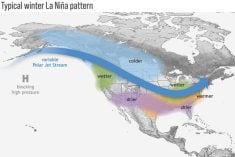Before we dive into the latest instalment of our Meteorology 101 classes, I want to take a moment to look at the just-released global temperatures from January, and to briefly examine the extent of Arctic and Antarctic sea ice.
NOAA, NASA, and the European Copernicus Climate Change Service all ranked January 2023 as the seventh warmest January on record, with the Japan Meteorological Agency ranking the month as the fourth warmest on record. Comparing temperatures to the 1880-to-1920 period, which is seen as the best time frame for pre-industrial temperatures, January’s global temperature was 1.14 C warmer. Europe recorded its warmest January on record with North America coming in with its fifth warmest, and Africa, its sixth warmest. While Oceania and Asia did experience a warmer-than-average January, it was not warm enough to rank within the top 20 years for those regions.
Moving on to polar sea ice: according to the National Snow and Ice Data Center, by the end of January the amount of Arctic sea ice was at the second lowest on record. In the Antarctic, which is nearing its summer minimum, the total sea ice extent has fallen to a record low of 1.91 million square kilometres. This is only the second time the summer minimum has fallen below two million square km, the first time being last year. While we have seen a definite downward trend in Arctic sea ice over the last 40 years, the Antarctic has not seen a statistically significant trend during that same time. There has been a sharp decline since 2016 in this region, but we will have to wait several more years to see if this is a trend or just variability.
Read Also

October rain recharges Manitoba soils
Daniel Bezte looks back on October weather on the Prairies and looks ahead to see whether there’s any consensus for this winter’s weather.
OK, now onto meteorology lesson No. 3! Last time we looked at insolation and the solar constant, which means we now need to take a look at global net radiation and seasons.
Net global radiation is the balance between incoming short-wave radiation from the sun and outgoing long-wave radiation from the Earth, as measured at the top of the atmosphere. To get a better understanding of this I’ve included a map of the average global energy balance where you can see, as expected, a very strong latitudinal component to the energy imbalances. We have surpluses of radiation (the Earth gains energy) in the equatorial regions (positive values), while there is a deficit poleward of around 36 degrees north and south latitude (negative values — the Earth loses more energy than it receives in these locations).
The areas with the greatest gains of radiation are over the Pacific and Indian oceans, right along the equator, whereas we see the largest deficit of radiation over Antarctica. Of interest are the negative values over the Sahara Desert, even though it’s in a fairly southern location — and this tends to be a hot place, so you would assume it must receive a large amount of radiation. It does, but due to predominantly clear skies and a light-coloured surface, it also loses a large amount of radiation.
In this simple average picture of global net radiation, we see the basics of what causes most of the weather around the world. We have a surplus of energy in the equatorial regions, while we have strong deficits in the polar regions. Weather is a result of the Earth trying to even out this imbalance. Unfortunately, it is not as simple as looking at an average picture.
The first thing we will throw into the mix are seasons — no, not seasonings; while the weather has often been described as “cooking,” we are talking seasons — you know: spring, summer, fall and winter? Most of us have at least a fundamental understanding of what causes the seasons, but did you know there are five reasons for the seasons?
The reasons for the Earth experiencing seasons are revolution, rotation, tilt, axial parallelism and sphericity — yikes! Most people think that it has only to do with the tilt of the Earth!
Let’s first look at revolution — the Earth’s orbit around the sun. What does this have to do with the seasons? Well, the Earth’s revolution, which takes 365.24 days, determines the length of each season. Secondly, we have the Earth’s rotation. Without our Earth rotating, the whole planet would basically have six months of daylight and six months of darkness. Due to our rotation, which takes approximately 24 hours to complete, we have 365 days in a year.
Along with the Earth’s rotation, we need to add in axial tilt. To picture this, imagine Earth is a spinning top doing a large orbit around the sun. Now, instead of picturing that top standing straight up and down, picture it leaning to one side, at an angle of about 23.5 degrees. This now means that at different times of the year, one end of the Earth points toward the sun, while the other end points away from the sun. This explains why different parts of the Earth have differing amounts of daylight.
To tie this into the seasons we need to look at axial parallelism: while the Earth is a spinning top tilted to one side at an angle of 23.5 degrees, it is always (at least in our lifetime) titled in the same direction (toward Polaris, or the North Star). As the Earth revolves around the sun, the tilt of the Earth remains in a constant direction, so for part of the year the southern part of our planet is pointed toward the sun and during the other part, the northern part is pointed toward the sun.
Our final reason for seasons has to do with the fact that the Earth is a sphere. This results in an uneven receipt of incoming solar radiation. Imagine how different it would be if Earth were flat, but don’t get me started on flat Earthers. The Earth is not flat, period.
Next class we’ll continue our look at the seasons and then, if we have room, we will begin our look at the composition of the atmosphere.
















